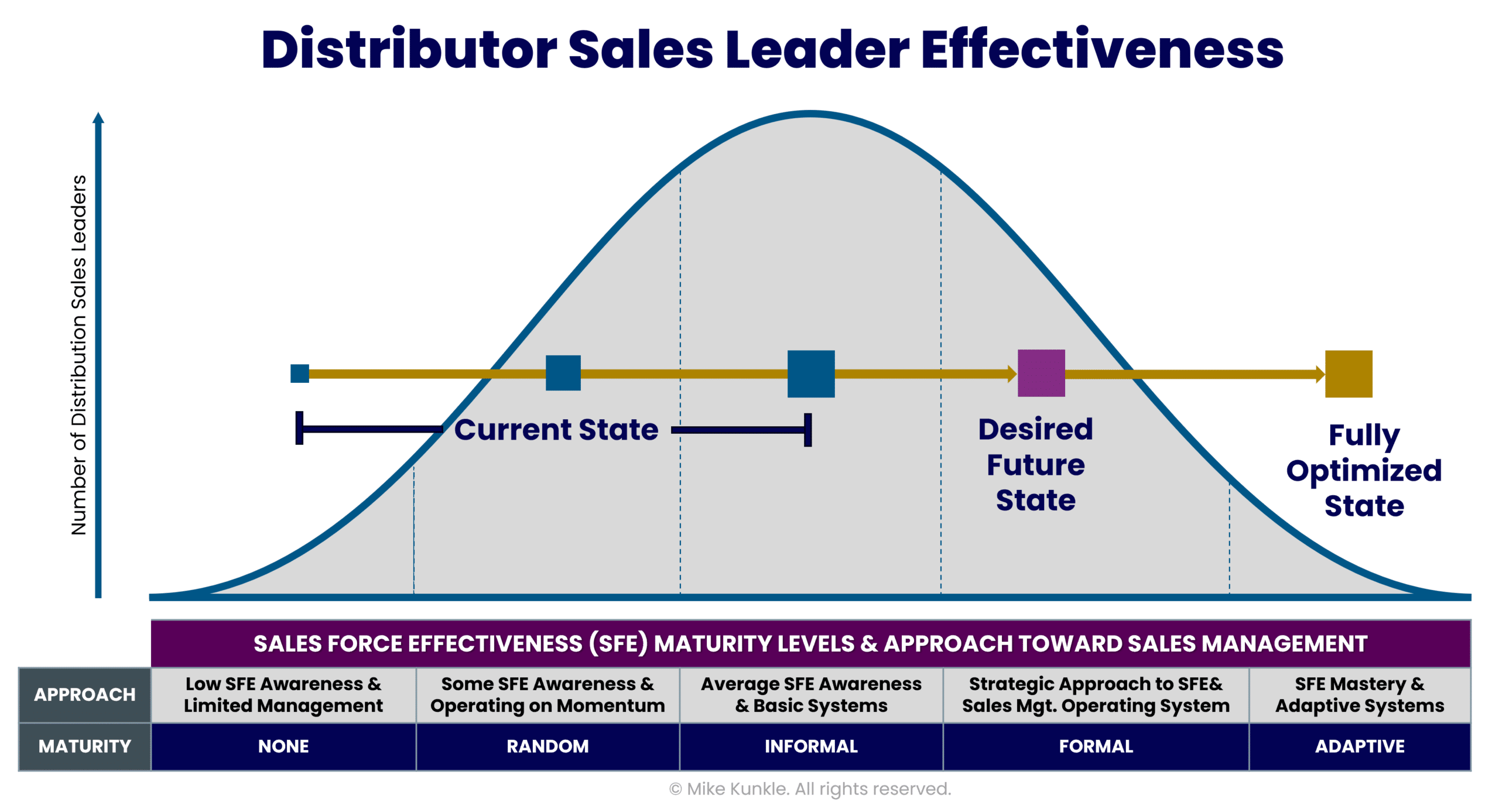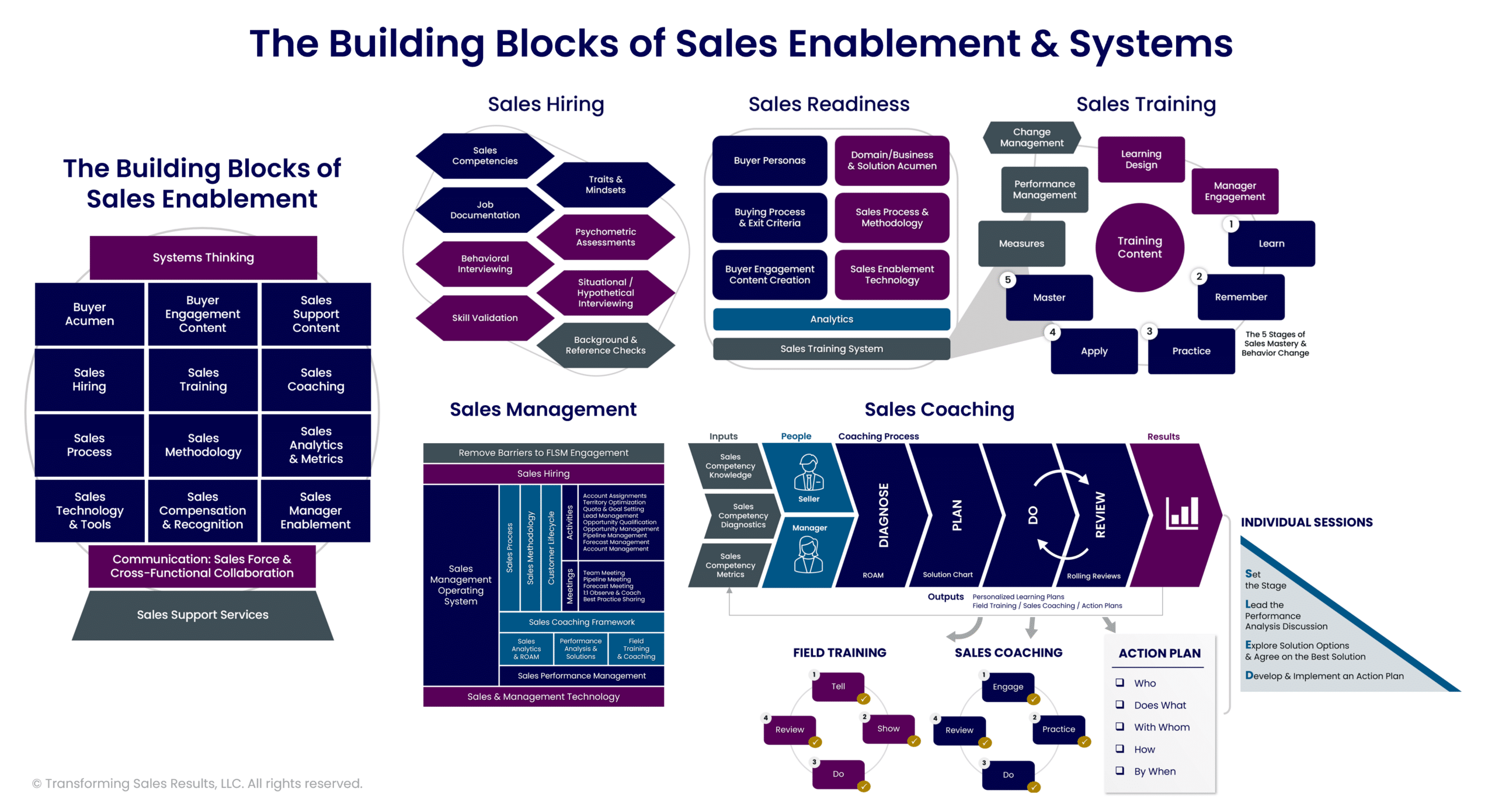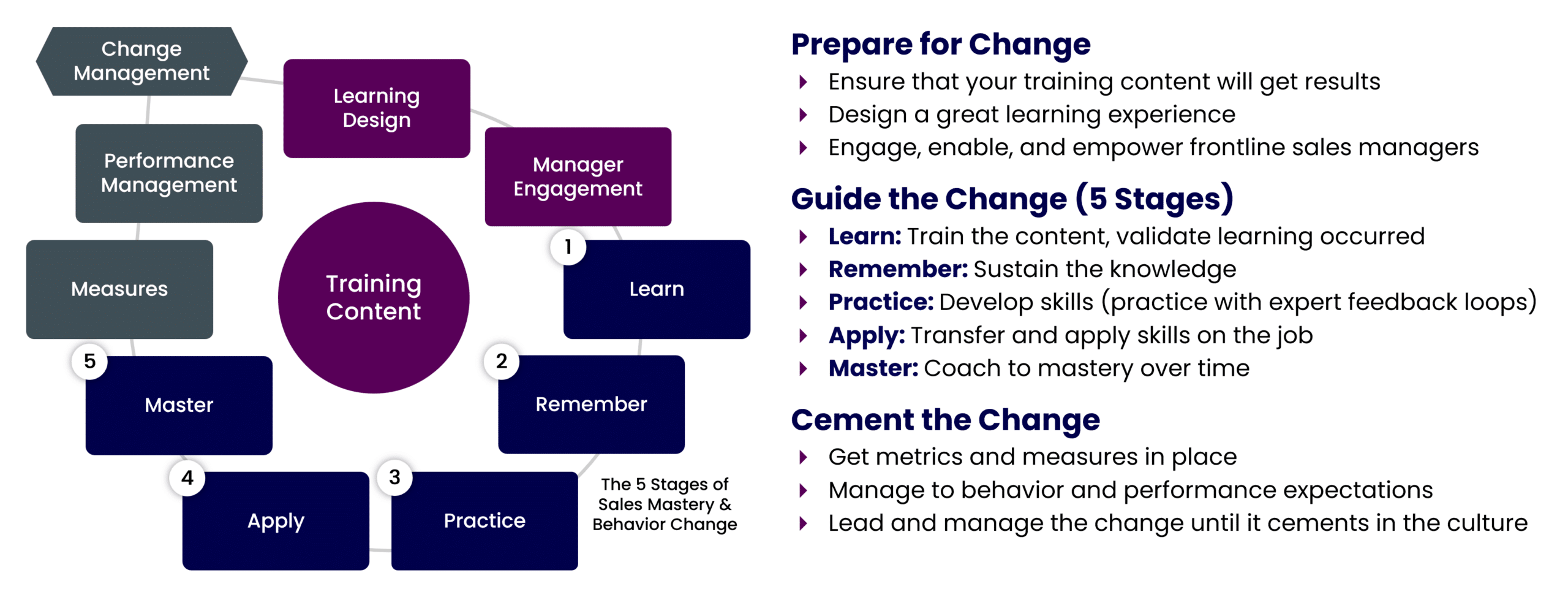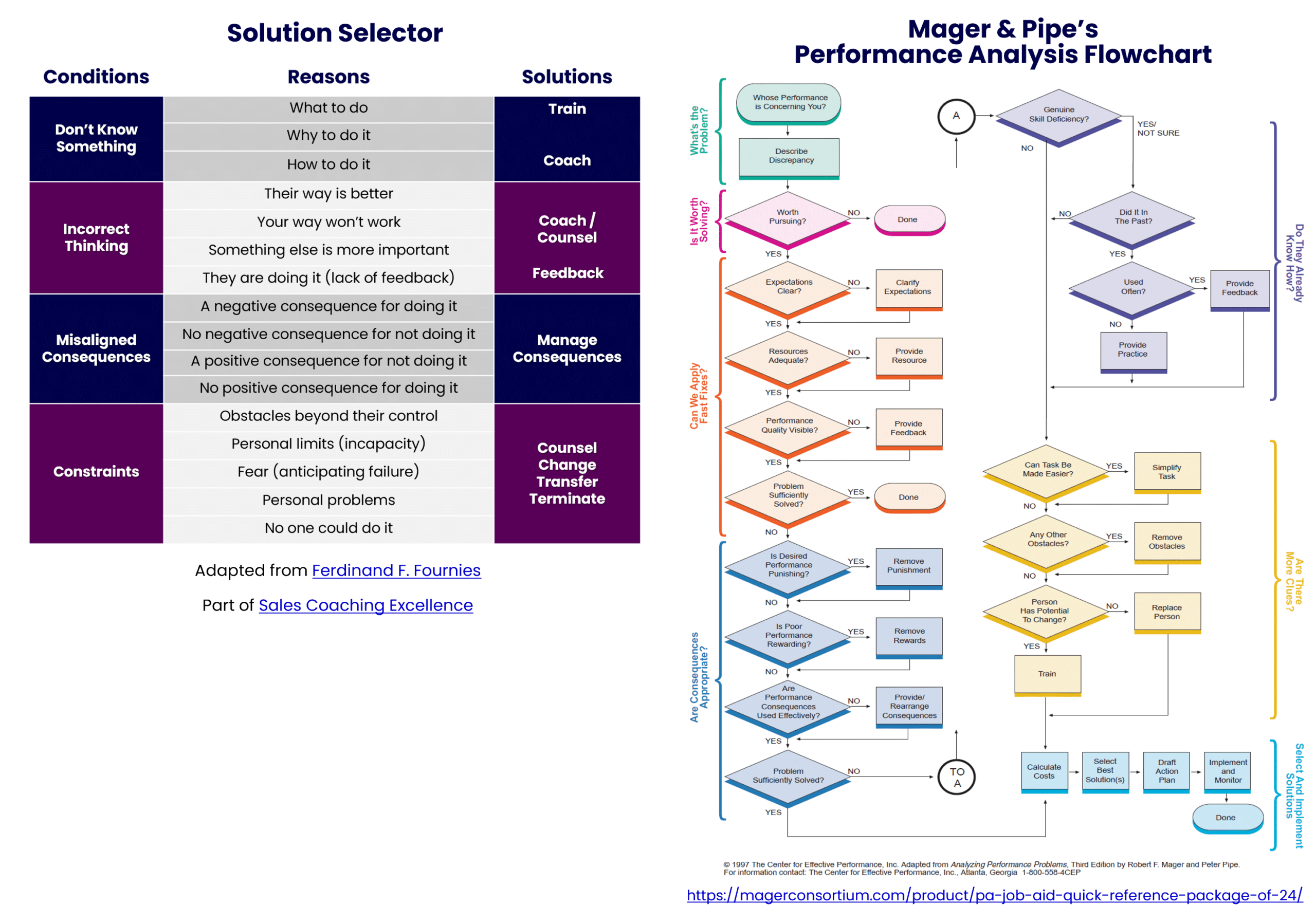As with most things in life and business, and as with most other professions, the knowledge, skills, capabilities and effectiveness of senior sales leaders in the distribution sector is a bell curve. There’s no insult intended with that statement – it’s just a fact. There are five other types of frequency distribution with data, but the normal or Gaussian distribution (bell curve) is the most frequent and typically applies in cases of intelligence and capabilities across a population.
[Click the image to view a larger version]
Because it is a mature vertical industry with deep customer relationships, and a focus on service delivery, wholesale distribution has not relied as much in the past on the current standard approaches to sales force effectiveness (SFE). Those include buyer persona research, sales process, sales methodology, sales technology and the myriad of performance levels and systems in my Building Blocks of Sales Enablement framework.
[Click the image to view a larger version]
But due to disruption, these are emerging in importance for wholesale distributor sales forces. This demands both sales transformation and digital transformation. Which requires change management and brings us back to that bell curve.
We know from multiple psychological studies that people generally overestimate their capabilities. It’s human nature. In a 1977 study, 94% of professors rated themselves above average relative to their peers. In 2018, the results of two nationally representative surveys showed that 65% of Americans believe they are above average in intelligence. (You, of course, know that it’s a 50/50 split.) This phenomenon is known as illusory superiority and has been studied for decades. (See this Wikipedia post on the Dunning-Kruger Effect for fun.)
“The first rule of the Dunning-Kruger club is that you don’t know you’re a member of the Dunning-Kruger club.”
– David Dunning, Psychologist
What’s my point? We are often poor judges of our own capabilities and frequently overestimate ourselves.
(Note: For balanced reporting, there is an ongoing debate about the validity of the Dunning-Kruger Effect. Human behavior is complex. There is no debate, however, about the studies on illusory superiority.)
Why am I writing about this here? Because this concept of illusory superiority occurs most frequently in sales leaders with long tenures, who would prefer to keep doing what they’ve always done, and believe they are doing the right things, despite massive environmental changes (VUCA, or volatility, uncertainty, complexity and ambiguity).
This reticence to change, or to manage change efforts, holds us and our organizations back from improving as much as needed and achieving our maximum potential. I have seen this impact firsthand, over many years, in many companies. I have especially seen it in sales leadership. And in my almost five years in wholesale distribution, I see it in our ranks, too.
In fact, one of the skill and capability gaps that I see recurring with alarming frequency among sales leaders is their overestimation of their ability to lead large-scale organizational change – or frankly, sometimes even minor change projects.
And this is what I want to explore with you today.
Why Change Management?

Change management methodologies were once only practiced by senior executive leaders and management consultants to drive large-scale business transformations. Given the level of disruption in wholesale distribution, change management is an essential skill that should be part of every sales leader’s repertoire.
Think about it. Whether you are implementing a new sales model, sales process, sales methodology, sales management operating system, sales coaching framework, CRM or other sales tech tool, what’s the most common hurdle? That’s right – it’s the lack of adoption. It’s the challenge of getting people to do what you want them to do.
Basically, you want them to change their behavior. In the learning and development profession, this is referred to as a “training transfer,” meaning to get learners to transfer or apply what they were taught on the job. Mastery can be gained over time, but if you can’t get your sellers to at least apply what they were taught, there’s no hope of improving performance. Meaning, no ROI, either.
This is certainly true with training but applies to all of the above examples and more. Leading change is a critical 21st-century management skill.
But wait! Your employees should just do what you say, right? After all, you’re paying them. You get to give the orders, and they get to follow them. That’s just how it is.
Uh huh. And that limited, old-school thinking is one of the reasons behind talent issues such as the Great Resignation, quiet quitting and employee disengagement, as well as the lack of adoption and failure of change initiatives.
“82% of distribution leaders believe that attracting and retaining the talent needed for growth will be the challenge for the next decade.“
~ Research from Dirk Beveridge
Change Management Madness
Allow me to share some examples of what I call “change management madness” with you, and to cite just a few of the barriers to effective change that I commonly see.
- Change management by proclamation: This is when sales leaders simply announce the change in some way and expect that everyone will fall in line. To be clear, it’s not always with the old Theory X intent mentioned above, either. Some sales leaders have the best of intentions with their change proclamations. In a sales force filled with employees from the baby boomer generation, this once had a much better chance of working (to a degree). You may not have garnered buy-in, or discretionary effort, but you had a better chance of compliance. Today, it’s far less likely to work, especially without context and a good understanding of why they should change.
- Change management by email: This is a version of the above proclamation that is even less effective, yet still overused. Through email, or a series of emails, executives or sales leaders send out their change communications. In some cases, the change messaging may be more complete than other proclamations, and may even include the why, what, how, when and where of the change. Yet, it’s still just email. This is a good option as a part of an overall change strategy and becomes more powerful when you use videos to tell stories (perhaps using ethos, pathos and logos – or credibility, an emotional appeal and the change rationale or logic). It can be a good start – as long as it’s not the entire change strategy.
- Change management fizzle: Even the best change management efforts are akin to stretching a thick, strong rubber band. If you don’t stretch it long enough, and hold it for a long enough time, it will snap back to its former shape as soon as you let go. Many change efforts don’t die with a bang; they fizzle with a whimper. And then, the status quo wins. If this happens more than once, employees who don’t favor a change will often adopt a wait-and-see attitude, display false consensus, and await the fizzle and snap-back.
- Change management overload: There are times in business when a major transformation is both urgent and mission critical to ensure business continuity. In these cases, massive transformation efforts are warranted. In other cases, leaders can unintentionally create overwhelm and change fatigue by altering too many major things at the same time with the same audience. It’s certainly possible to run multiple change projects at the same time, but there is only so much that any one employee or department can absorb at once, especially if you are expecting significant behavior changes and high levels of adoption. It’s like the old joke, “How do you eat an elephant? One bite at a time.”
- Change management by cookie-cutter: Cookie-cutter approaches rarely produce great results across all projects. Templates and checklists are helpful, but not all change projects are the same. Implementing a new travel and expense policy is not the same as training sellers on a new account management methodology or implementing a CRM across the entire company. It’s a great first step to adopt a formal change management methodology. Once you do, being ready to dynamically adapt that method (or use more than one model) will produce better results.
Change Management Mastery
Avoiding these common change management missteps and mastering change will vastly improve your chances of success. In this section, I’ll share change methodologies. But regardless of the specific methods that you employ, these best practices are worth mastering:
Ensure the value of the change: This sounds simple, and can be, when there is only one change effort. When there’s more than one, consider prioritizing based on the:
- urgency and impact of the problem you’re solving
- importance of the outcomes of the state you’re aiming for
- risks of failure
- audiences affected
- cost of the solutions and the potential ROI, if the outcomes are achieved
- pain of change or how difficult it will be to navigate the change and get adoption
Right-size the method to the change effort: This is about aligning the change method to the complexity of the project. With a simple project, Lewin’s “Unfreeze, Change, Refreeze” model could be an excellent choice. For a large-scale project of high complexity with urgent business risks and outcomes, Kotter’s 8 Steps, McKinsey’s 7-S or Prosci’s ADKAR model could be better choices. Expanding or contracting the model you choose to fit the context will serve you well.
Purposeful planning: Even a great model that’s well selected but poorly implemented doesn’t yield results. If it’s a major change, consider an internal advisory committee (or more than one), made up of representative employees at all levels from the affected groups.
Gain buy-in from key people: Again, the more significant or critical the change, the more important it is to pave the way for success and anticipate roadblocks. You can use a relationship map to assess the buy-in levels of key stakeholders and plan accordingly. Assess their level of influence in the company and whether they are a positive, neutral or negative force relative to the change initiative. It’s helpful to identify champions and anticipated detractors; it’s also important to work to strategically cultivate champions and manage or convert detractors. You’ll especially want to solicit support from your influential champions.
Overcommunicate: According to change expert and author, John Kotter, most companies under-communicate their visions for change by at least a factor of 10. In addition to that, messaging content is critical, too. Change messaging should be developed for all levels of employees, from front-line workers to their direct managers, and straight up the leadership chain to the executive level. Then, companies should help managers at each level adapt the messaging to be relevant, clear and compelling for their employees. Part of this messaging should entail how the leader will support their team through the change. This older post from The Harvard Business Review offers outstanding advice on reaching front-line employees through their direct supervisors. It’s timeless advice.
Share progress transparently: You can do this for project tasks and overall project progress, the measurable leading and lagging indicators of the project itself, adoption rates, and the resulting change in outcomes/results. You can also share any other reasonable metrics that indicate how well or poorly things are going. Sharing transparently, rewarding people, learning quickly from failure and holding people accountable will go a long way toward keeping things moving forward.
Systematize the change: This is about establishing new processes, workflows, performance support and reporting. And then integrate the new behaviors into the fabric of the business and your employees’ and managers’ daily work. This, combined with the next two ideas, will help you cement the changes into your culture.
[Click the image to view a larger version]
Maintain a Measure/Evaluate/Adjust/Execute loop: I frequently remind leaders of two axioms:
- What gets measured gets done.
- What gets asked about, gets focus.
To share progress transparently, as mentioned above, you first need to measure it. After planning and executing, that measurement then allows you to evaluate progress, pivot and adjust, as needed, and execute on a better path. This loop sounds so simple and logical, but I don’t always see it in action.
Stay the course: This staying power is what counters the common “change management fizzle,” mentioned in the section above (the rubber band analogy). Don’t let up or lose focus until the change becomes “the way we do things around here.”
As with the above list of challenges, this one isn’t inclusive either. But these suggestions are inherent in many of the popular change models and will be helpful for guiding your change project toward a successful conclusion.
Learn and Explore Change Models
To wrap up, I’ll share some change models that you can explore further.
The first is my Sales Training System, which I’ve written about here before. Not all change projects are training related, but the framework includes what I call “The 5 Stages of Sales Mastery & Behavior Change,” which you can also apply outside of sales training situations, whenever behavior change is the goal.
The Sales Training System
[Click the image to view a larger version]
For more on this model, see this post, How to Get Business Value from Sales Training.
Other Change Management Models
- Lewin’s Change Management Model and his Force Field Analysis.
- Prosci’s ADKAR Model
- Kotter’s 8-Step Change Model
- McKinsey’s 7-S Model
Whichever model you use, you should always choose the most appropriate change management methodology for your project.
- Identify the nature and scope of the change
- Assess your organization’s culture and readiness for change
- Consider the available resources and expertise
- Evaluate the potential risks and benefits
- Engage stakeholders and get buy-in
- Lastly, don’t be afraid to mix and match models
Ultimately, any change management methodology will be better than none. Yet, it’s worth taking the time to explore and evaluate, as the right model has the potential to make your change management journey easier (and deliver the outcomes you and your leadership team hope for).
By taking a structured and thoughtful approach, you can improve your chances of successfully implementing change and achieving the desired business impact. And for senior sales leaders, that means better results, more satisfied customers, and ultimately, profitable growth.
Lastly, it can be helpful to have tools to assess how to address why people aren’t doing what you want – and the solution to that.
[Click the image to view a larger version]
The Solution Selector adapted with permission from Ferdinand F. Fournies’ work is part of my Sales Coaching Excellence course. The Performance Analysis Flowchart is from Bob Mager and Peter Pipe’s work and is available through the Mager Consortium. Both can be helpful in assessing why people don’t do what you need them to, and what to do about it. Which, I promise you, you’ll need to do in any major transformation project.
Closing Thoughts
I hope this article has been helpful for you. For CEOs and senior sales leaders, there are few things more important than being able to lead organizational change effectively. If you found it valuable, have questions or want to share your perspective, I hope you’ll reach out to let me know.
Mike Kunkle is an internationally recognized expert on sales enablement, sales effectiveness, sales training, sales coaching, sales management, and sales transformations.
He’s spent over 30 years helping companies drive dramatic revenue growth through best-in-class enablement strategies and proven effective sales systems.
Mike is the founder of Transforming Sales Results, LLC where he designs sales training, delivers workshops, and helps clients improve sales results through a variety of sales effectiveness practices and advisory services.
He collaborated to develop SPARXiQ’s Modern Sales Foundations™ curriculum and authored their Sales Coaching Excellence™ and Sales Management Foundations™ courses.
Mike's book, The Building Blocks of Sales Enablement, is available on Amazon, with others coming soon in 2026, starting with The CoNavigator Method for B2B Selling.






